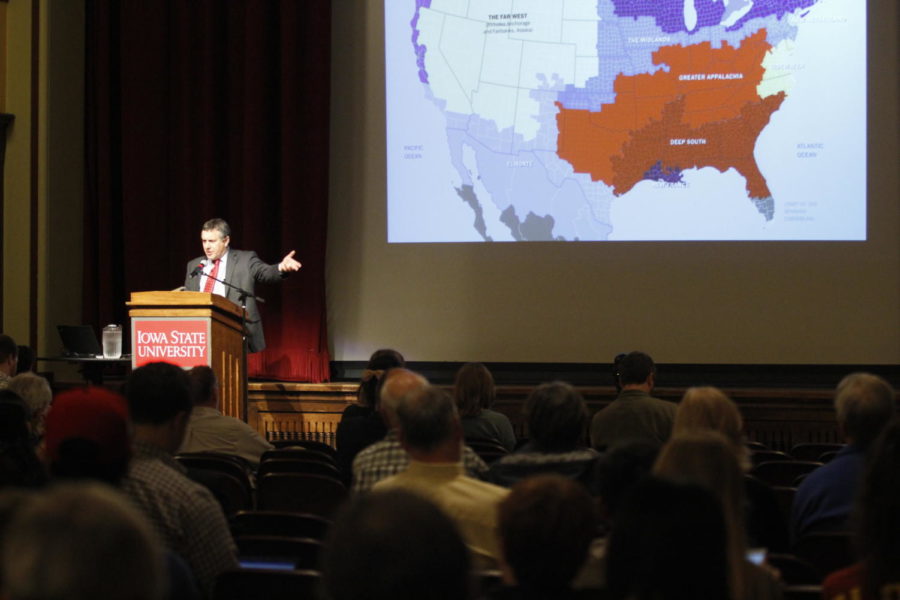Lecture informs students about future of politics and elections
Makenna Martin/Iowa State Daily
Colin Woodard spoke in the Great Hall of the Memorial Union Oct. 6. Woodard talked about the red state/blue state myth and culture wars.
October 7, 2015
Colin Woodard, author and journalist, spoke at the Great Hall in the Memorial Union to students about the eleven possible culture regions of the United States of America
There are eleven culture defined regional nations in the United States of America according to Colin Woodard — Yankeedom, Tidewater, New Netherlands, Greater Appalachia, the Deep South, New France, The Midlands, El Norte, The Left Coast, The Far West, and First Nation.
Woodard’s lecture is part of the national affairs series, with C-SPAN broadcasting Woodard told his audience about how our culture wars are inevitable.
“There was a Civil War in this place called the south that’s apparently still fighting it,” said Woodard.
Presidential candidates decide on what to say to people depending on where they are in country, he said.
“We no more a united culture, a united nation than Europe is,” said Woodard, adding the United States is divided not just by regional and state lines, but by cultural lines as well.
“We hear about regions but it’s always fed through the lens of a set of regions defined using state boundaries,” Woodard said.
The regions that Woodard means is entirely different and has more to do with who first settle an area and the traditions that surround it.
Yankeedom and the Midlands were colonized by the English and Germans respectively. From Massachusetts to North Dakota is the land colonized by those from the Yankeedom culture. From Pennsylvania to the Rocky Mountains houses the Midlands.
The New Netherlands was founded by the Dutch at a time when the Netherlands was the sophisticated society in the world. It was a multiethnic and multicultural trading center and become what is New York City and the surrounding areas.
The Tidewater region is found around Virginia and was made up of the younger sons of the British gentry. It was the most powerful nation in the 18th century.
Greater Appalachia and the Deep South were brought up next. Greater Appalachia was made up of Celtic warrior types from Ireland and Scotland. The Deep South was a society transferred from the slave based societies of Barbados.
El Norte was the oldest of the European settlements. It’s Hispanic based and very self-sufficient. It began because of how far this nation was from both Mexico City and Spain.
The second generation nations came about through exploration of the west. The Left Coast was colonized by New Englanders of Yankeedom who came by sea and settlers who braved the terrain of traveling by land.
The other nation to spring up in the second generation. “The environment totally trumped ethnography,” said Woodard. The Far West had such a harsh environment it required vast resources to be colonized.
New France grew from the French in both Canada and New Orleans. It is a combination of French and Native American cultures and is the most liberal in social values.
As you go north in to Canada you’ll encounter the newest and oldest nation. The First Nation is made up of Native Americans who haven’t given up their land. The occupy the storehouse of North American Natural resources.
“I thought it was very interesting,” said Brian Schulze, a sophomore in engineering. Schulze said it’s fascinating that all of the political divisions aren’t quite as important and that our values are more based on regions.
“I’ve never pictures America in that sense before,” said Tony Kuehn, a junior in agriculture studies. “He had some sound logic behind it.”
“The culture splits our voting tendencies as a nation,” said Megan Frisvold, a sophomore in global resource systems. She also finds it interesting in how it affects our voting.

















